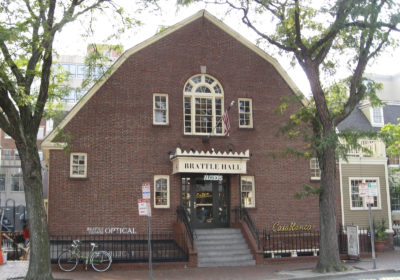
Outfitumentary — the portmanteau word is about as strange as the 82-minute film of the same name. Yet upon further contemplation, the mashup of words makes an absurd sort of sense. “Outfitumentary” is, in its simplest form, a documentary about director K8 Hardy’s outfits. In reality, however, the film is so much more than that.
Hardy, a self-proclaimed unapologetically lesbian feminist, filmed “Outfitumentary” over the course of 11 years. Beginning in 2001, the artist took full-body video shoots of her daily ensemble using a mini-DV camera. She then cut together each clip to create the full-length film, a sort of montage of her journey from adolescence to adulthood through her outside appearance.
The documentary begins with Hardy as a teenager in an oversized denim shirt and a pink skirt, her hair brushed out to lay flat on her shoulders. She is in her childhood bedroom, awkwardly ambling about and leaning against door frames while avoiding eye contact with the camera she set up. At this point Hardy is a typical teenage girl with a passion for thrift shopping.
Fast forward through more recordings of tube tops, heels and dresses to Hardy’s more masculine look. Her hair is shorter, her clothing has evolved to trousers and button-downs, and her head is adorned with a stereotypically lesbian-esque snapback. She is also much more confident, laughing into the camera and chatting with friends offscreen.
This spirit doesn’t dim as the recorded days progress, as Hardy continues to dance and pose happily regardless of whether she’s in a blazer and tie, a revamped men’s wrestling uniform or bright fuschia leg warmers. Her overwhelming sense of self radiates from each of her wardrobe choices, many of which the average person wouldn’t dare to wear in public. Hardy is happy — she’s comfortable in her skin, in this fashionable world that exists outside of conventional gender norms.
The self-exploration that Hardy visibly undergoes challenges the societal pressure to conform, particularly when applied to people exploring their sexualities and gender identities. It’s not uncommon for members of the LGBT community to experiment with various labels until they find one that fits. Hardy did the same, except she used dramatic wardrobe changes and color combinations to help her along the way.
Although Hardy claims “Outfitumentary” wasn’t intended to be art at its inception — she described her past self as simply a “video hoarder” at a screening of the film at the Brattle Theatre in Harvard Square on Wednesday — it still presents a beautiful representation of self-acceptance and the modern queer experience.
The film itself outlines its goal in the first few moments, as stop-motion handwritten text invites viewers to watch Hardy as she acts “like a peacock in [her] flamboyant queer and feminist clothes.” Beyond these introductory notes, the film is completely void of voiceovers and commentary from Hardy, leaving viewers to fill in the gaps and interpret the deeper meaning of the outfits and expressions parading across the screen.
The lack of narration fits under the umbrella of the ever-evolving standard for experimental filmmaking. Hardy provides a vague outline, and then the audience is set free to find their own understanding, almost as if interpreting the cinematic equivalent of poetry.
However, even the most confusing literary poetry usually comes to a fairly brief end, and there’s typically a SparkNotes guide to accompany it. In “Outfitumentary,” the video-montage drags on for over an hour, harping on the same “point” until it enters the realm of boredom. There is also no explanation for the various setting changes, identification of the other people sometimes within the frame, or even a timestamp to indicate how many years have passed between shots.
It’s quite possible that the omission of essentially all relevant information is intentional, a way to allow viewers to project their own thoughts and journeys onto what they view on the screen. This decision does not take into account, however, that not every viewer is queer, or female, artsy or fashionable, or undergoing an identity crisis.
Yet the statement Hardy makes through the film is universal — or, at least, should be delivered on such a scale. She reminds viewers that outward appearance is temporary, and does not serve as a definitive personality trait in any capacity.
Whether it be 11 years of fuzzy video footage from a cheap and slowly breaking camera or Hardy herself showing up to speak at film premieres in her multicolored, heavily makeuped presence about her life, Hardy’s message is hard to miss: “Outfitumentary” is more than dress-up. It’s a radical personal transformation that just so happens to manifest as skirts, button-downs and dresses — and a whole lot of pink.
























































































































